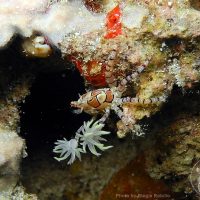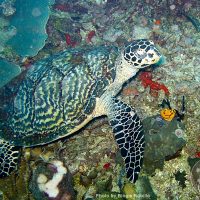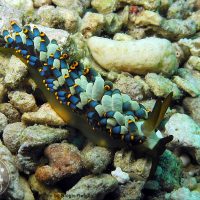Discover Scuba Diving in the Philippines
Island-hopping, sunbathing, sailing, surfing… While these activities are what immediately come to mind when thinking of our islands, many remain unacquainted with the breathtaking attractions and otherworldly charm of scuba diving. And that’s a shame, because our country is blessed with some of the best diving destinations in the world. No exaggeration.
On Facebook, for instance, there are scores of pages and groups populated by scuba divers from across the globe. What’s immediately apparent looking at these online international communities is that the Philippines ranks among the top go-to places for diving. After all, we do have the most-dreamed-about dive site on the planet: the World Heritage Site, Tubbataha Reef.
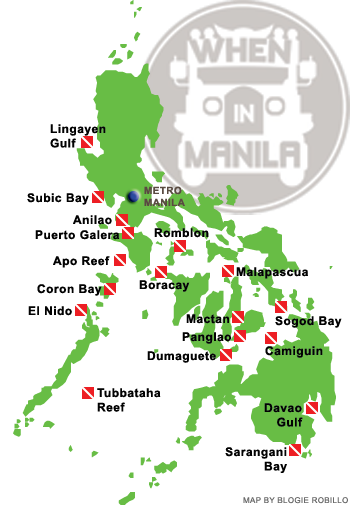
Just a few of the Philippines’ dive destinations
Aside from Palawan’s pride, many localities across the archipelago have long been known for scuba diving, and plenty more are up and coming. Some of the more popular destinations are Anilao (Batangas), Apo Reef (Mindoro), Coron Bay (Palawan), Dauin (Dumaguete), Mactan (Cebu), Panglao (Bohol), Sogod Bay (Southern Leyte), and Subic Bay, among others.
Of course, divers—Filipino and foreign—have their own favorite local islands and will swear by them. For example, my fellow Davaoeño divers and I love our underwater haunts around Samal & Talikud Islands in the Gulf of Davao. We have several dive operators here, bringing divers out to more than a dozen choice dive sites. Plus, we’re thankful that typhoons rarely ever touch our shores, making Davao City an ideal place for getting S.C.U.B.A.-certified all year round.
Divers are also natural-born travelers. While I take pride in my hometown’s dive sites, I’m always eager to experience the undersea offerings of other destinations. Divers plunge into the deep for different reasons, you see. For most, it’s that unique and thrilling encounter with marine life in their natural habitats. And for some, it’s a desire to see particular or sought-after marine critters. (Say you like swimming with majestic thresher sharks — the best site for that is Monad Shoal, off the coast of Malapascua Island in Cebu.) I know of many divers who have a bucket list of to-do stuff, which they get to tick off each time they visit a new place.
One other thing I enjoy is the sense of community among divers. At dive shacks or on dive boats, it’s easy to make new friends. Even in coffee shops or such, when you see someone sporting that eye-catching “diver below” flag, approaching fellow divers for conversation seems very natural. I guess this is because diving is such a specialized activity where you go through rigorous training and exhilarating experiences, that you know for sure you have something in common with anyone bearing that red-and-white banner. And naturally, it helps that divers have their own jargon, not to mention distinctive hand signals.
So what does it take to get into diving? (Oh look, summer is just a couple months away!)
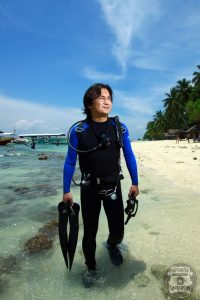
Surface interval
Just like any sport or hobby, you’ve got to be very interested and committed. The skills involved are easily developed and do not require a bodybuilder’s physical strength or a gymnast’s agility. However, it’s an intensive activity in terms of concentration and attentiveness. After all, human beings aren’t naturally adapted to the marine environment, and making serious mistakes beneath the waves could lead to grave injury… or worse. But, as long as you get yourself properly trained and made completely aware of every contingency, this pursuit can be safe and entirely worth every peso you spend.
Speaking of which, not unlike golf, scuba diving entails a bit of an initial investment. There is a set of equipment on which you’ll likely spend a tiny fortune, especially if you’re the type who likes getting their hands on high-end gadgets. A serious diver will want to own at least the following: a buoyancy control device (BCD), a regulator set equipped with air and depth gauges, a pair of fins and booties, a wetsuit, and a mask. If you settle for reliable brands which won’t set you back a year’s pay, this set could cost you around forty grand (in pesos).
I started putting my scuba gear together by going for bargains. There’s always some sale or promo going on in scuba dealerships, and there are several of them in Manila and Cebu. A lot of divers, for peace of mind, prefer acquiring brand-new equipment. However, if you’re on a tight budget, join online forums where people unload their pre-loved gear. Another way to save, especially when you’re still only starting out, is to hold off on purchases and just rent equipment from your dive shop. (Here in my fair city, Carabao Dive Center rents out a complete set for only ₱1,500 a day – and that includes boat fees and two dives!)
Once your mind’s set on taking the plunge, the first step is to get what we call a c-card (I think of it as my ‘sea card’). It’s your diving license, issued by a scuba certifying agency. You’ve probably heard of PADI, but there are other agencies—NAUI, SDI, SSI, etc.—and they’re all basically the same. In Davao, an Open Water Diver’s course (the beginner’s level) costs between twelve to fifteen grand, depending on your choice of scuba agency and dive operator. Your c-card, by the way, will be recognized and accepted worldwide.
I suggest you take up scuba lessons during a vacation. If you’re going to spend summer or a Christmas break in, say, Puerto Galera or Romblon, you’d do well to go through the training while you’re there. It takes three or four days to get yourself certified, with at least two of those days getting yourself wet. There will be a written exam, of course, so your instructor can assess whether or not you’ve come to thoroughly appreciate the wonders of water pressure and the dreadfulness of decompression sickness.
- Boxer crab
- Hawksbill sea turtle
- Nudibranch (T. yamasui)
After obtaining your c-card and finding yourself going out to sea more and more, you’ll realize that each diver ends up specializing, so to speak. Myself, I fell in with the underwater photographers crowd, even though I’ve only ever dabbled in photography topside. Others discover a passion for spelunking (but probably not if you suffer from claustrophobia), and there are those who go wild over wreck diving. Still others realize that they want to build a career in diving and aim to become professionals: dive guides, dive masters, instructors, and commercial contractors for deep-sea assignments.
No matter what you end up loving in this lifestyle-changing hobby, you’ll do exactly that: love it.

